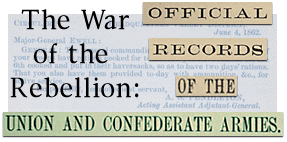Summary:
Union cavalry general Alfred Duffie reports on June, 1864, action in the Shenandoah Valley.
Duffie reports taking command at Staunton, and capturing and burning a Confederate wagon train
running from Staunton to Lynchburg.
July 9, 1864.
SIR:
I have the honor to submit the following report of the operations of this division from the 10th day of June, 1864, up to the present time:
Pursuant to paragraph 20, Special Orders, No. 112, headquarters Department of West Virginia, dated June 9, 1864, I took command of the First Cavalry Division, at Staunton, Va., June 9, 1864, relieving Maj. Gen. Julius Stahel. In accordance with orders from department headquarters of same date as above, I moved my division at 3 a. m. of June 10, 1864, on the Waynesborough pike toward Tye River Gap. I sent Lieut.-Col. Root, Fifteenth New York Cavalry, with two squadrons of that regiment to make a demonstration against Waynesborough. He found their pickets six miles from the town, attacked and drove them into the place, where he found the enemy in force; drew the fire of their artillery, and aroused their whole camp. From prisoners subsequently captured, I ascertained that the whole rebel force at Waynesborough lay in line of battle for four hours, expecting a general attack from our army. Lieut.-Col. Root and his command manifested great gallantry in the execution of this movement. His losses were 1 killed and 1 missing. While Col. Root was making the demonstration upon Waynesborough, I moved my command by a road to the right of the town, toward the Tye River Gap. My advance at about noon encountered the rear guard of Jackson's command had just passed on the way to join Imboden at Waynesborough. Marching twenty-five miles this day, I encamped near the mountain in which Tye River has its source. Lieut.-Col. Root joined me with his force near this place. Near this camp I caused to be burned an extensive furnace for the manufacture of pig-iron which had just been refitted to be used for the benefit of the rebel Government. From this camp I sent a communication to department headquarters at Midway, twenty-two miles distant. I also sent out two small parties across the mountains toward the railroad with orders to burn bridges and tear up the track. These parties, however, were unable to accomplish the object, the country being infested by the enemy.
On the morning of June 11, having awaited for some time to receive orders from department headquarters, I moved forward my command over the mountains and through Tye River Gap into the valley of the Tye River, leaving one regiment to picket the gap. From this point I again sent an officer, with an escort of fifteen men, bearing a communication to the major-general commanding the department. On the morning of this day having ascertained from a dispatch which was captured that a rebel wagon train, on its way from Staunton to Lynchburg, was moving some twelve miles ahead of my column, I sent forward a squadron, under Maj. Daniel, of Second Maryland Cavalry (First Maryland Potomac Home Brigade Cavalry) to capture the train. He succeeded in overtaking the train, driving back to guards and capturing a considerable number of wagons; also in capturing about 40 prisoners, including 7 commissioned officers, 3 of whom were rebel quartermasters. Maj. Daniel brought off some six or seven wagons, loaded with hams, flour, and other stores, but was obliged to destroy the remainder of the train, the horses having been taken off and the harness cut to pieces. From the quartermasters captured, I learned that property was destroyed in one wagon. Hundreds of thousands of Confederate money and bonds were burned, and all the books and papers belonging to the several quartermasters. One quartermaster remarked that the damage could only be estimated by millions. A considerable number of horses were also captured. On the afternoon of this day I sent a party of ten men and one sergeant from Capt. Rennison's pioneers to destroy the railroad at Arrington. During the night they returned, having burned Arrington Depot, containing a large quantity of boots, shoes, and other quartermaster stores; also destroying four small bridges and tearing up the railroad for a distance of three or four miles. This work was very brilliantly executed by the sergeant in charge.
Bibliographic Information : Letter Reproduced from The War of The Rebellion: Official Records of the Union and Confederate Armies, Series 1, Volume 37, Serial No. 70, Pages 139-140, Broadfoot Publishing Company, Wilmington, NC, 1997.

